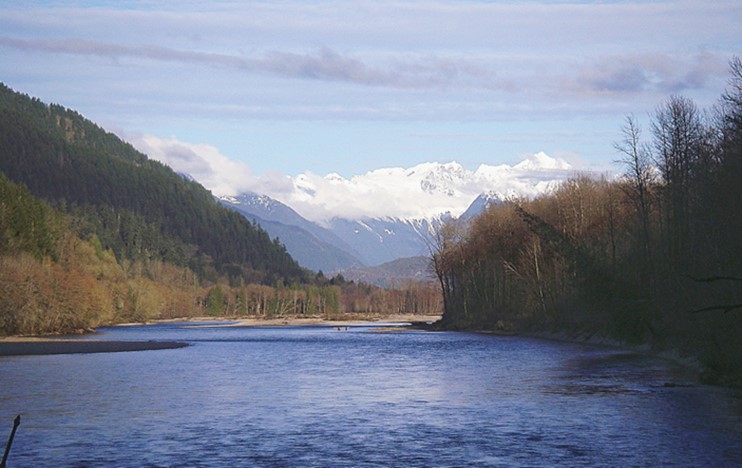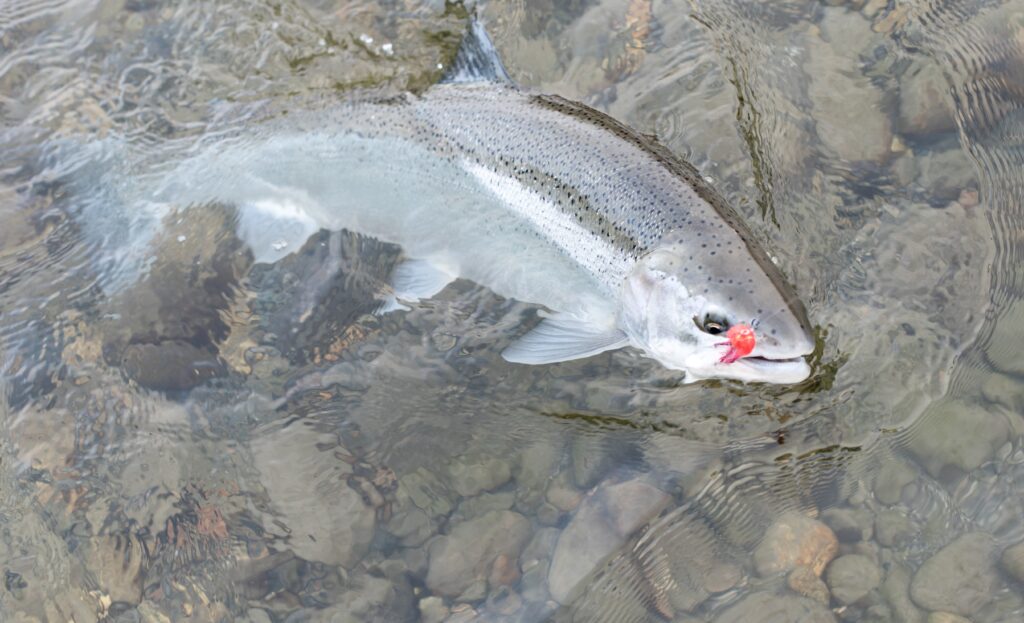
Wild times, these. In my experience wading thigh-deep in a steelhead river is one of the best ways to leave the world behind. One’s attention is simultaneously focused on staying upright, managing line, picking a target for your cast, and envisioning a steelhead grabbing your offering. An occupied mind can be a good thing.
Like it or not, it is hard to deny that our world is changing rapidly. Many of those changes are concerning, and feelings of loss and instability seem pervasive. To combat those feelings, in this issue of our quarterly newsletter for generous supporters, I want to share hopeful news about our favorite fish: wild steelhead. I hope that it buoys your spirit and reminds you that good things continue to be possible when the people who care the most work together to make them happen.
The Skagit River in northwest Washington — the third largest river on the Pacific coast by volume — is familiar to many steelhead anglers. I have several friends in their 80s who first fished for steelhead on the Skagit and its largest tributary, the Sauk, 50 years ago, sparking a love affair that continues to this day and motivates them to stay in shape for “one more go at it.” Personally, it was where I cut my steelheading teeth back in the ‘90s.
But the Skagit’s wild steelhead fell on hard times in the early 2000s (truth is, their decline started decades earlier.) In 2007, the river’s wild steelhead were listed as “threatened” under the Endangered Species Act, and the sport fishery was closed in 2010. In response to the ESA listing and a subsequent lawsuit, the Washington Department of Fish and Wildlife closed its Skagit winter steelhead hatchery program in 2014. So today, except for a few hatchery strays, the Skagit system is populated by wild fish.
We’ve heard this lament many times over the years: if you shutter a hatchery, you eliminate fishing opportunity. But the Skagit belies that assertion.

After the fishery and hatchery closure, the Skagit’s wild steelhead population rebounded. The projected run this year is over 7,000 fish, allowing for both a tribal (harvest) and sport fishery (C&R, selective gear). The sport fishing season stretches for 2.5 months, from February 1st through April 15th.
One decade ago, there was no sport fishery in the Skagit despite the resurgence of wild steelhead in the mid-teens. At that time our Wild Steelhead Initiative team amplified the advocacy of anglers asking WDFW to open a catch-and-release sport fishery. For several years on a designated weekend anglers gathered at Howard Miller Steelhead Park in Rockport to mount a friendly protest, which was creatively named “Occupy Skagit.” It took several years of public pressure and advocacy, but we ultimately prevailed, and NOAA Fisheries approved a joint fishery management plan developed by WDFW and the tribal co-managers (a plan that we helped shape) for the Skagit in 2018 allowing anglers to once again fish these hallowed waters.
The joint fishery management plan, which has been extended through 2032, is innovative in several respects. In addition to selective gear rules, restrictions on fishing from a boat, and area restrictions, a noteworthy feature of the fishery is that the allowable fishing impact (i.e., tribal harvest and sport fishing incidental mortality) is adjusted annually based on the projected annual run size. To have a sport fishery at all, the projected run size must be at least 4,000 fish. Above that threshold the allowable impact stair-steps up to a maximum of 25% when the run projection exceeds 8,000 fish. In addition, the plan requires robust in-season fishery monitoring.

Image: Ed Sozinho
While there is room for improvement (we believe the 25% maximum encounter rate is too high to enable the population to rebuild to its potential) the plan is conservation-oriented and provides a model we would like to see adopted in other wild steelhead systems. We don’t want the perfect to be the enemy of the good here, though we will continue to seek improvements working collaboratively with WDFW.
But our work was not done with passage of the fishery plan. Every other year, we advocate in Olympia for the funds WDFW needs to implement its management scheme, Quicksilver Portfolio, for steelhead in Puget Sound rivers, including the Skagit. TU’s Wild Steelhead Initiative team was a lead architect of the Quicksilver Portfolio and building angler support for it. To date, we have partnered with WDFW to secure from the state legislature the roughly $8 million needed to support the Skagit fishery and other Quicksilver actions, primarily the collection of data to enable informed management decisions and implementation of hatchery reforms in other rivers. Good steelhead management requires adequate funding.
To succeed at our mission of rebuilding wild steelhead populations and providing responsible angling opportunity, we have to cover the full policy and funding cycle and be ever vigilant. The Skagit is a case in point, and our work was made possible by you – our generous supporters who enable us to do it year-in and year-out. I’m always available to discuss opportunities to support our work, and Scott Reinstein, in TU’s Development office, is always happy to share ways to support this work, whether by check, stock, or with a tax-advantaged gift.
I’ll close by directing your attention to the excellent blog written by our outstanding Wild Steelhead Scientist Advisor, Gary Marston, which was posted on our Wild Steelheaders United site March 18th.
His blog post, cheekily titled Happy Wild Steelhead Day in Washington!, illuminates a critically important assumption driving winter steelhead in western Washington: that hatchery fish spawn before March 15th and wild fish spawn after that date. Gary’s blog explains why this management assumption is flawed, particularly with regard to systems with integrated hatcheries; how it impacts wild steelhead populations; and how it affects angling opportunity.

Image: Copi Votja
And as we try to do whenever we point out a management problem, Gary proposes a potential solution and gives WDFW a pat on the back for starting to address the problem while also urging more robust action.
I’ll note: We create these pieces to educate our members and supporters and to drive science-based fisheries policy, but we know managers are reading them because they often bring up our blog posts during calls and meetings whenever we publish these critiques.
There are a few more weeks of spring steelhead fishing ahead in coastal rivers from northern California to Washington State. I hope you get out and enjoy the longer days and warmer temperatures before the season comes to a close. I’ll be back in June with the next edition of the newsletter.
As always, we are grateful for your support.
Rob Masonis
Vice President Pacific Region